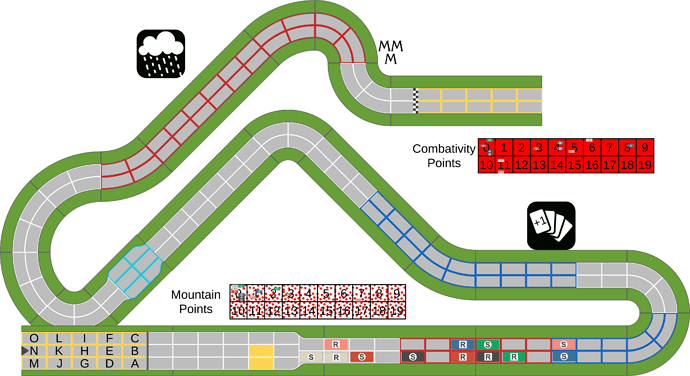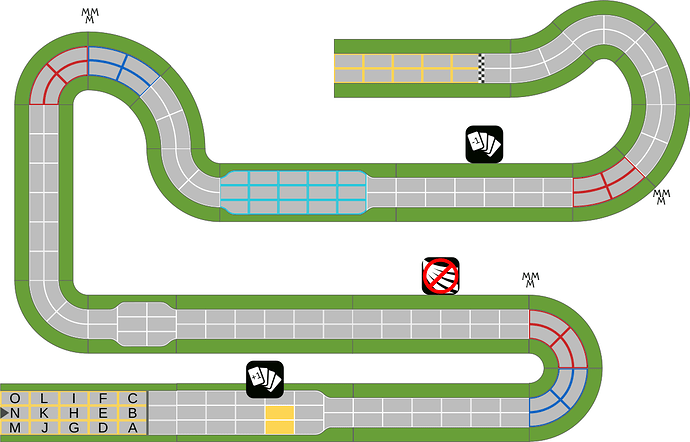Here’s a game image. Please check that this works with your colour vision. You don’t necessarily need to be able to read the small mountain and combativity tracks, but you should be able to identify the riders and the coloured borders on some of the squares. I can tweak colours if you like.
Can I be pink please?
Colour vision is a bit of a speciality of mine as an Optometrist. There’s an app called CV Simulator which uses the camera on your device to show you what someone who has a colour deficiency sees, it’s very good.
Thanks. I also use Coblis when I’m designing for a mass audience. But if all the players in this game can work comfortably with the standard colours, that makes my life slightly easier.
I’d like to be blue, please!
Looking forward to spectating this one!
Seems I’m already losing the race of colors! Well anyways, I’ll go with red then 
And to be sure, will this be multiple legs, or just one track?
This is planned to be a six-stage Tour - the scoring is a bit fiddly, but the short version is that the top three finishers on each stage get points, and each rider retains half their exhaustion cards at the end of each race.
Great! I’ll settle in for the long haul then!
I’ll take green, since purple isn’t an option 
Being in NZ, I have to go for black
@spindrift, are you happy with white?
Btw, that Alp d’Huez stage looks criminal… 
Long uphill in the rain - what could possibly go wrong? 
OK, @spindrift hasn’t logged in since 23 April. I think we may therefore have another slot open.
Well, they said they’d never done a pbf before, so may not be up to the expectation of being on every day.
Yes, that is kind of basic, isn’t it? connect once (or even better, twice) a day. If not the pace suffers.
Ah, what the hell, I’ll take the open slot. White, right?
Correct!
I shuffle the virtual cards, and the courses are:
- 3 Cholet
- 8 Amiens
- 11 La Rosiere
- 12 Alpe d’Huez (if you’ve been following the Peste I’m sure you’ll be happy about that)
- 20 Espelette
- 21 Champs-Élysées
So here is your first course:
(You lot get the benefits of the improvements I’ve made during other games, like lettered starting grids and mountain point reminders.)
Placement order:
| GabrielH | green |
| Captbnut | pink |
| COMaestro | white |
| Minato | red |
| Lordof1 | blue |
| Chewy77 | black |
I’ll do a quick rules refresher shortly.
OK, experienced players please have a look at this and I’ll edit in the stuff I’ve inevitably missed out.
Definitions
A “space” consists of multiple “lanes”. Each lane can hold one cyclist. The rightmost lane is very slightly in the lead, so you always move to the right at the end of your movement if possible.
A single turn
- I’ll post the current layout and a hand of cards (normally four) for each rider. Don’t look at anyone else’s!
- Choose one of your riders (Sprinteur or Rouleur). Look at their hand, and pick one card to play; the rest will be discarded and come back later. You must pick this card before looking at the other rider’s hand (which is why they’re in separate hidden areas); then do the same for the other rider. Let me know what cards you’ve played, by private message or in a hidden details block (click the cogwheel in your editor and “Hide Details”). Note that the card you play will not be available again this race.
- All played cards are revealed; all unplayed cards go to the discard pile. From the front to the back, each rider moves a number of spaces equal to their card’s value. If a space is full (all lanes are occupied), you can move through it, but you can’t stop there; if it would have been your last space, you stop before it.
- From the back to the front, any rider with just one empty space between them and the rider in front slipstreams forward one space, along with any riders immediately behind them. Note that this is by the space – it doesn’t matter which lane you’re in.
- Then, any rider with one or more empty spaces in front of them gets an exhaustion card (“X2”) to their discard pile.
- Then start a new turn. When you run out of cards to draw, the discard pile is shuffled and turned to a draw pile. In the very unlikely event that you run out of cards completely, you can always draw and play an X2.
- The rider furthest across the line in the turn when any rider crosses the line is the winner.
Breakaway
There are two yellow spaces in front of the starting grid. We’re not playing the whole race, but only the final stages, from the point at which riders start to push out ahead of the pack. So at the start of each game:
- Choose one of your riders, look at their hand, and pick a card to bid.
- When everyone’s done this, the cards are revealed.
- With a second hand of cards, pick another card to add.
- The two riders with the highest bid lose those cards, gain two exhaustion, and move forward to the yellow spaces. Everyone else gets their cards back. Ties are broken in favour of the rearmost rider.
Terrain
- If any part of your move is on a red-bordered space (uphill), your speed may not exceed 5 whatever card you played. (This means that if your 6th move would be onto an uphill space, you stop just short of it.) Riders on uphill spaces do not benefit from slipstreaming, nor can they be slipstreamed from.
- If you start your move on a dark-blue space (downhill), if you play a card lower than 5 it counts as a 5.
- If you start your move on a light-blue space (supply zone), if you play a card lower than 4 it counts as a 4.
- Riders on cobblestone (shown as brown or with a cobblestone texture) spaces do not benefit from slipstreaming, nor can they be slipstreamed from.
Weather
There are four sorts of weather, each of which applies to all spaces on the straight piece to which it’s attached:
- Headwind ("-1" icon): your starting hand is one card smaller.
- Tailwind ("+1" icon): your starting hand is one card larger.
- Crosswind (crossed-out “whoosh” icon): riders on these spaces do not benefit from slipstreaming, nor can they be slipstreamed from.
- Wet: if you have to stop short because the space at the end of your move is full, and the space you end up on is wet, you crash. One crashed rider prevents slipstreaming to or from that space. If all lanes are full of crashed riders, nobody else may pass. Crashed riders lose 2 points off the value of the card they play next turn. (After any adjustment for downhill/supply zones.)
The Tour
- At the end of the stage, each rider keeps half their exhaustion cards (round up) to take into the next stage.
- The first three riders to finish (furthest across the line on the turn they cross it) get 3/2/1 tour points. Placement order for the next race is in ascending order of tour points.
- The first two riders to leave each uphill (red) section get 2/1 mountain points. In a change from the other games, I’m going to use the same rules as for finishing - i.e. on the turn that people leave that uphill section, the rider furthest ahead gets the 2 mountain points.
- If you get an exhaustion card and you’re in the lead or joint lead, you get a combativity point.
- Times are assigned based on finishing order: each space over the line is a ten second bonus, each turn after the winner is a one minute penalty. If there’s a block of riders who finish together, they all share the leader’s time. First two finishers get a 10 second bonus.
- At the end of the tour, the top three riders in each class (mountain points, combativity points, times) get 3/2/1 tour points.
- The tour winner is the rider with most tour points; the team winner is the team with most tour points.
I know Cholet, it’s not far from where we go on holiday and home to Puy du Fou
Summary
Just trying the hidden text thing

